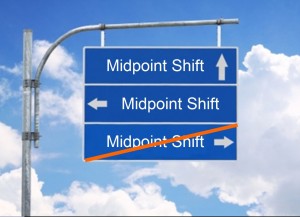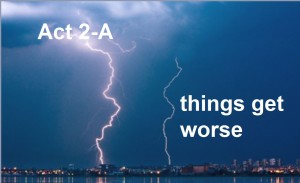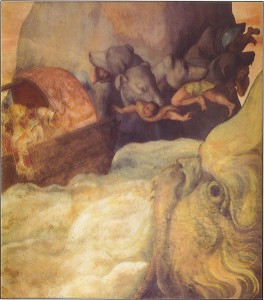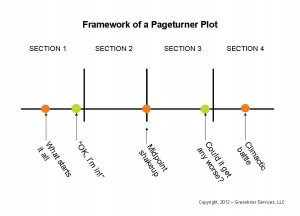After the series of new disasters the hero experience in Part 2b of Act 2 (see previous post), we come to the Second Turning Point.
This is also known as the death experience
The second turning point also is a disaster; in a dramatic reversal, the hero is yet again frustrated in achieving his goal.
But this disaster is mega.
Here’s a good way to brainstorm your second turning point: Ask yourself “what’s the worst thing that can happen to my hero?” Then make that happen.
At the second turning point, one or all of the following should hold true:
- The hero feels he has lost everything he set out to gain.
- The hero has run out of options/appears to have exhausted his last option.
- Discovers that the new information he received at the story’s midpoint (see previous post on the Midpoint Shift) has led to dead end.
- His goal no longer seems attainable to him. (The reader may know how the hero can attain the goal – but hero doesn’t see how at this point.)
- Hero is weak, shattered, discouraged, beaten down; antagonist is going strong, appears to have victory within his/her grasp.
The second turning point ends Act 2b of your novel (the middle of your novel), and launches Act 3 (your novel’s resolution).
Examples of the second turning point:
- In Bridget Jones’s Diary, Bridget starts to like Mr. Right (Mark Darcy), but after he fights with Mr. Wrong (Daniel Cleaver), she rejects Mark as she misinterprets the reason for the fight. (She’s still after Mr. Right but now no longer is open to seeing Mark Darcy as Mr. Right.)
- In The Fellowship of the Ring, the hero Frodo is wounded by a dark force (stabbed by a Nazgul), and his death appears imminent.
- In Jaws, one of the men seeking the shark with the hero (Chief Brody) destroys the radio with a baseball bat, revealing his madness and ensuring that the crew’s encounter with the killer shark will be a do or die venture.
- In The Fugitive, the hero discovers that the man he believes guilty of his wife’s murder is innocent, apparently leaving him once again at square one in his quest to clear himself of suspicion.
Create your second turning point, and you’re in your novel’s home stretch – for a novel of average length, that means just 10 or 15 or so scenes to go.
Happy writing!







